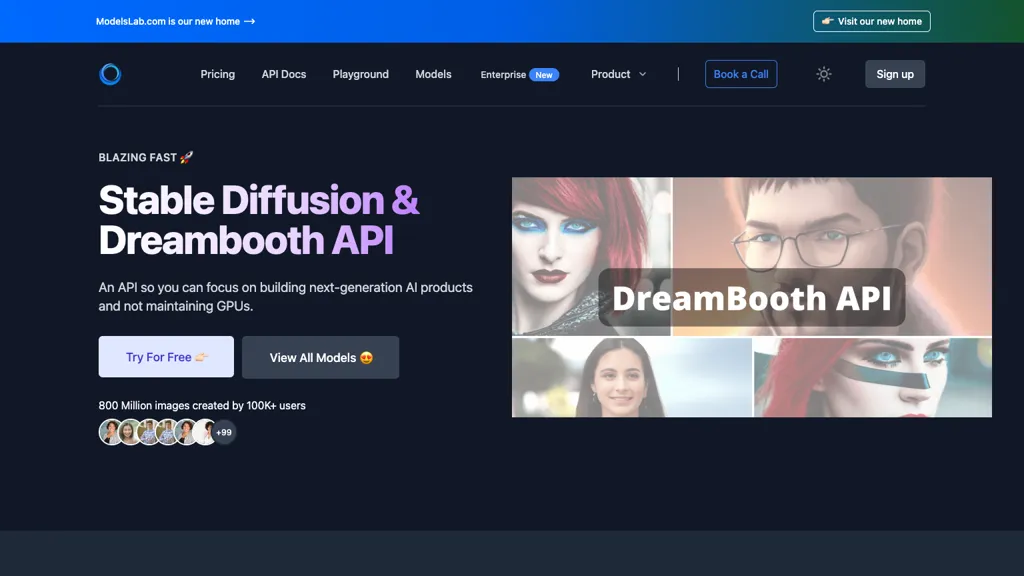What is Stable Diffusion Dreambooth API?
Stable Diffusion Dreambooth API is a flexible tool allowing users to create fine-tuned dreambooth stable diffusion by a set of API functionalities. It has more than 99 different APIs, including uncensored chat API, voice cloning API, text-to-image generation, and interior design API—very broad AI capabilities for a variety of applications. It is a tool for building next-generation AI products, supporting model training, image editing, text-to-image generation, and real-time AI processing. The reason for doing so lies in the convenience provided by the ability to integrate very strong models of AI within different systems with relative ease. Faster and more reliable, Stable Diffusion API makes for a solution trusted by more than 1000 companies to help serve all AI development needs without maintaining GPUs.
Stable Diffusion Dreambooth API’s Key Features & Benefits
Stable Diffusion Dreambooth API is replete with a package of features and benefits that make it one of the favourites for many users. That includes the training of custom models for specific AI needs, editing images with advanced AI editing tools, high-quality text-to-image generation from textual descriptions, processing AI on real-time bases combined with fast speed, and a few other salient features. This also provides fast and quick integration into diverse systems.
It provides a wealth of advantages, from productivity to inspiration and simplicity of integration, thus making it one of the most important tools for both AI developers and researchers. The major USPs include its extensive APIs, ease of use, quick setup time, and more.
Stable Diffusion Dreambooth API Use Cases and Applications
The Stable Diffusion Dreambooth API applies in many scenarios and is best suited for various industries.
-
Marketing Campaigns:
Realistic and Easily Customizable Dreambooth Stable Diffusion Images for Effective Marketing Visuals. -
Product Visualization:
Detailed images of products to be used on e-commerce platforms. -
Artistic Projects:
A singular piece of artwork based on AI-generated imagery. -
Interactive Chatbots:
Uncensored chat API to create chatbots and virtual assistants that can speak freely. -
Interior Design:
Interior design API can facilitate integration such that it can provide virtual room visualization, suggest furniture placement, and personalized interior design solutions.
These applications demonstrate the versatility of Stable Diffusion Dreambooth API in enhancing various projects and industries.
How to Use Stable Diffusion Dreambooth API
Using Stable Diffusion Dreambooth API is pretty easy. Just follow the steps below:
-
Sign Up:
Go to the Stable Diffusion Dreambooth API platform and create an account. -
Select a Plan:
Select the plan that best suits your needs. You can start with a free trial. -
Use the API:
Get your API key from the dashboard. -
Integrate the API:
with the documentation provided into your application. -
Get Started:
Use all the functionalities of the API to start different tasks. It will train models and edit images.
Best practice, ensure that you really follow the documentations very closely and make use of the resources that have been made available for support.
How Stable Diffusion Dreambooth API Works
The Stable Diffusion Dreambooth API is realized based on state-of-the-art AI technologies. State-of-the-art machine learning models and algorithms drive functions such as text-to-image generation and real-time AI processing. Basically, this means that the workflow for using this API will involve inputting data—like the text descriptions used for image generation—processing it using respective AI models available in the API, and outputting the desired result, in this case a generated image.
Stable Diffusion Dreambooth API Pros and Cons
Like any tool, Stable Diffusion Dreambooth API has pros and possible cons associated with it.
Pros:
- It offers an exhaustive suite of APIs for almost all varieties of AI functionality.
- Easy-to-use interface allowing fast integration.
- High-quality AI models for accurate results.
- Reliable performance that requires less maintenance.
Cons:
- Requires a steep learning curve due to the newness of AI technologies.
- The pricing may be a little steep for small business uses or individual users.
Generally speaking, feedback from users focuses on the ease of use and the general power of the API; though users do remark that sometimes, setting this up can prove to be a bit difficult.
Conclusion about Stable Diffusion Dreambooth API
The Stable Diffusion Dreambooth API is an extremely powerful and versatile tool with huge diversity in AI functionalities. Its core aspects, such as model training and generating images from text, offer immense value in many applications. Although there are a few drawbacks, in general, user reviews are very good and emphasize its ease of use with good powers. Where one wants to implement advanced AI technologies into their projects, the Stable Diffusion Dreambooth API is absolutely recommended. Further developments and updates will expand its possibilities of use even more.
Stable Diffusion Dreambooth API FAQs
What is the Stable Diffusion Dreambooth API?
Stable Diffusion Dreambooth API – is a platform that allows users to utilize a range of API functions to generate fine-tuned dreambooth stable diffusion.
For whom is the use of Stable Diffusion Dreambooth API most suitable?
The Stable Diffusion Dreambooth API may be very useful for AI researchers, product developers, artists, designers, chatbot developers, and specialists in voice cloning.
What are the pricing options for the Stable Diffusion Dreambooth API?
The API offers a free trial, with paid plans costing $27 per month for its Basic Plan, $47 per month for its Standard Plan, and $147 per month for its Premium Plan.
How to Get Started with the Stable Diffusion Dreambooth API
First, create an account, choose a plan, get an API key, and implement the API with the application through the guidelines documented.
Can you mention some of the drawbacks of the Stable Diffusion Dreambooth API?
Well, the major cons are a steep learning curve for those who have no experience with this kind of technology, along with pricey pricing plans for smaller budgets.










